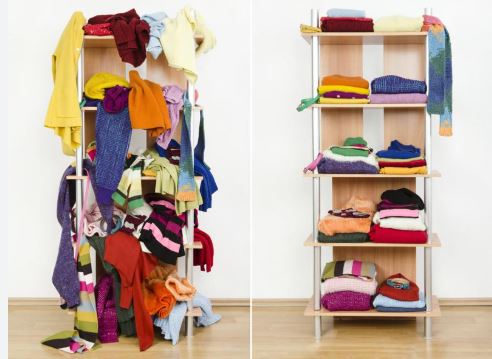How I Found a Better Way to Declutter
One personal philosophy I live by is simple: never knock something until I’ve experienced it myself. Even when I’m skeptical or flat-out disinterested, I’ve learned that jumping in with an open mind can be eye-opening—or at the very least, entertaining.
This mindset has led me to some unexpected conclusions. I’ve discovered that octopus is definitely not my thing (it’s the texture more than the taste). I’ve realized I prefer the predictability and perks of a well-run hotel over the unpredictability of most Airbnbs. And yes, I blast smooth R&B instead of thrash metal while working out. That last one tends to catch people off guard, but hey—slow jams, strong reps.
So when Marie Kondo’s minimalism movement hit the mainstream with her bestselling book The Life-Changing Magic of Tidying Up, I figured I’d give it a go. A structured system for simplifying life by shedding excess? Sounds right up my alley. But as I dove in, things started feeling… a little odd.

Tidying or Talking to Your T-Shirts?
Reading Marie’s work was like walking into a spiritual retreat, except the guru was telling me to thank my socks for their service. Seriously. Her approach goes far beyond decluttering—she wants you to have a full-on relationship with your wardrobe.
Here’s a glimpse into what I read:
“Folding isn’t just for storage. It’s an act of gratitude. Clothes serve your life; honor them with care.”
“Run your hands over your folded shirts and tell them you appreciate them.”
“Ask every object: Does this spark joy? If not, discard it.”
While I get the intention behind it—appreciation and intentionality—I couldn’t help but feel like I had stumbled into a self-help sermon for sweaters. Look, I believe we all hang on to too much junk, but I draw the line at emotionally bonding with my drawer of gym shorts.
The Sentimentality Paradox
Marie’s method presents an interesting contradiction: she encourages detachment from overly sentimental items, yet urges you to build emotional ties with the things you keep. That kind of emotional logic didn’t resonate with me.
When I moved recently, I got rid of years’ worth of accumulated stuff. My secret? Ruthless practicality. I didn’t ask if my backpack “sparked joy.” I asked: Do I use this? Do I need this? Can I live without this? That kind of clarity made the process fast and stress-free.
The key to letting go wasn’t emotional enlightenment—it was a straightforward decision-making process.
The Closet Overhaul That Changed Everything
Let me tell you about a closet purge I did for a client named Arvind. This guy had over four full closets of clothes. No exaggeration. He was overwhelmed, unsure what to keep or toss, and clearly stuck in decision fatigue.
That’s where I came in. Since none of his garments had emotional value for me, I approached it from a pure style and function perspective. I sorted everything into two piles: keep what looked good on him, and ditch what didn’t.
Here’s the twist: every time I tossed an item, Arvind would nod and say something like, “I always thought I should get rid of that. I just needed someone to confirm it.”
He already knew the answer—he just needed a little push to act on it. The clutter wasn’t in his closet. It was in his head.

Stop Overthinking, Start Editing
Most people delay cleaning out their closet because they’re tangled in indecision. What if I need it someday? What if I lose weight and it fits again? What if it becomes stylish next year?
None of that helps. If you’re trying to reclaim space and clarity, you need a filter that’s based on logic, not hypotheticals.
That’s why I created something to make the process as painless as possible—a one-page Closet Edit Cheatsheet. It’s the exact framework I use when helping clients, laid out in a way that makes fast decisions easy.
Your Personal Decluttering Blueprint
You might not be able to hire me unless you live in New York, but with this cheatsheet, it’s like I’m right there beside you, calling the shots.
It’s not filled with abstract ideas like “energy flow” or “joy levels.” It’s a checklist that cuts through the chaos. With it, you’ll know exactly what stays and what goes. Most people can work through their wardrobe in less than an hour. Even the most overloaded closets rarely take more than a day.
No chanting. No hugging your sweaters. Just clarity, simplicity, and space for the things that actually matter.
A Fresh Start Without the Fuss
At the end of the day, the real magic isn’t in whispering thank-yous to your winter coat. It’s in reclaiming control over your environment. A clean closet isn’t just about aesthetics—it’s about mental bandwidth and daily ease.
So if you’re feeling bogged down by too much stuff, forget the rituals. You don’t need to connect with your cardigans on a spiritual level. You just need a little structure, a bit of decisiveness, and the right system.
With the right mindset—and maybe the right cheatsheet—you’ll be amazed at how quickly you can simplify your space and upgrade your life.
Did You Know?
- Marie Kondo encourages people to physically thank their clothes for their service before discarding them.
- A structured cheatsheet can help declutter even the most overstuffed closets in under an hour.







